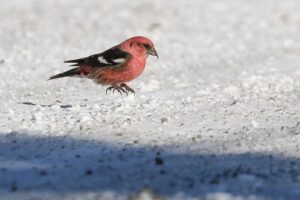There are a lot of ways to categorize birds. Waterbirds versus land birds, flying birds versus flightless ones, and whether birds are nocturnal or diurnal are all important distinctions. Another less obvious distinction is between hopping birds and walking birds.
You might not have thought to sort observations about these movements into categories. But have you ever seen a sparrow, a chickadee, or a cardinal take steps? Conversely, have you ever seen a robin or a gull leap, with both feet off the ground, as they bound across the landscape? The answer, in all likelihood, is no.
In 2020, a pair of researchers decided to investigate this dichotomy. Pauline Provini, an associate professor at the Museum Histoire Naturelle in Paris, and Elizabeth Höfling, a zoology professor at the University of São Paolo, wanted to understand how walking and hopping behavior evolved. They took a chart called a phylogenetic tree that depicts the evolutionary relationships among more than 1,000 birds and labeled each bird as walking or hopping. Their goal was to determine whether walking or hopping came first and to understand what makes birds become one or the other.

The earliest birds almost certainly walked, they found. The most primitive birds today, like ostriches, emus, and kiwis, all walk, while many of the most “evolved” birds — those belonging to families that diverged from other birds most recently — tend to hop.
This finding makes sense: birds evolved from dinosaurs, and according to everything scientists know, dinosaurs walked. But what drove those more “evolved” birds to change course and start hopping?
One theory is size. It’s easier for lighter birds to move quickly by hopping, since they have less weight to pull through the air. But there are a lot of heavy birds that hop: Toco toucans, for instance, hop, and they weigh up to two pounds — as much as most ducks. Meanwhile, smaller birds, like blackbirds and robins, walk instead of hop.
Another theory is evolutionary relatedness: if a bird started hopping tens of millions of years ago, then all of its descendants today would hop as well. While this holds up somewhat (all geese walk and all sparrows hop, for example), there are plenty of exceptions. Warblers generally hop, but a type of warbler found on Cape Cod known as the ovenbird walks along the forest floor.
The best explanation, the researchers found, was arboreality, or tree-based living. For birds, trees provide a safe place to live and access to food. But walking from branch to branch is difficult, and having to fly every time you want to move is a huge waste of energy. Hopping, Provini and Höfling wrote, is the least exhausting way for birds to climb up a tree, while also allowing for higher maneuverability in dense branches.

Arboreality explains many of the more surprising cases of locomotion, too. The largest hopping birds, like toucans, are arboreal, and the smallest walking birds tend to be birds that spend most of their lives on the ground. There are still a few exceptions, like parrots, which walk in the trees. Nevertheless, this theory appears to make sense.
But it doesn’t explain why birds seem “locked” into one of these modes. Robins seem to have a hard time hopping between branches without using their wings, and sparrows don’t suddenly start walking when they’re on the ground, despite the large amount of energy they would likely save by doing so.
Evolution, it seems, forces birds down a particular path, and the evidence is in their different pelvis sizes. Hopping birds, the researchers found, have wider and shorter pelvises, and the parts of the pelvis associated with balance and cushioning are more developed. In hopping birds, too, the parts of the pelvis that anchor the hip flexors and knee extensors — the muscles that help their legs brace when they land — are more prominent. The opposite is true for walking birds: they have longer pelvises and larger anchors for the leg muscles involved with pushing the body forward.
These differences in pelvis shapes make each bird’s mode of locomotion much easier and often make the other mode all but impossible.
The remarkable part of Provini and Höfling’s study is the way it reveals how much the need to conserve energy exerts evolutionary pressure on birds. For hopping birds, millimeters of change in their pelvises were sometimes the difference between living long enough to reproduce and dying without young. Before long, those beneficial pelvis traits became standard in those species as they became exclusively hoppers. And that ability to hop allowed those birds to fill niches that no other bird was occupying, helping them to diversify into new species.
Without these millimeters of change in the pelvis, perhaps we would not have the diversity of birds we have today. And we certainly wouldn’t have any birds celebrating leap day — today or any other day.



